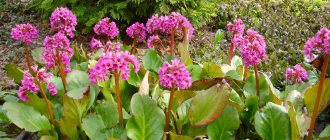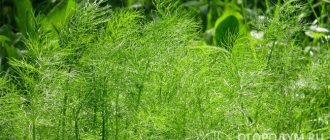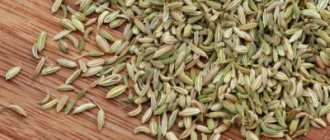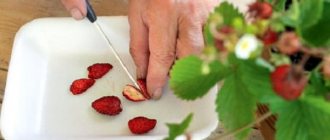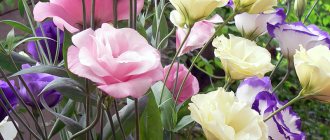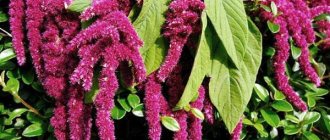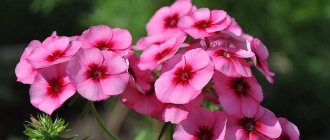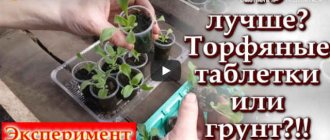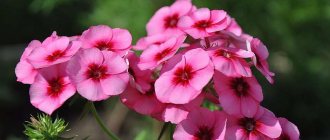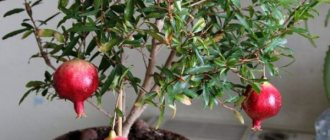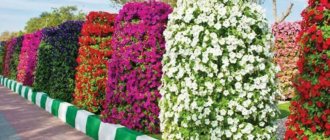Author: Elena N. https://floristics.info/ru/index.php?option=com_contact&view=contact&id=19 Category: Garden plants Published: February 28, 2019Last edits: January 13, 2021
- When to plant
- Growing conditions
- How and when to collect seeds
- Bergenia stracheyi (Вergenia stracheyi = Вergenia gorbunowii)
- Medicinal properties
The herb bergenia, or bergenia (lat. Bergenia), forms a genus of perennials of the Saxifraga family. These perennial herbs grow in the temperate zone from Korea and China to the countries of Central Asia, settling in rock cracks or on rocky soil. Bergenia was introduced into culture in the middle of the 18th century under the name “saxifrage thick-leaved,” but then it was taken into a separate genus and given a Latin name in honor of the German botanist Carl August von Bergen. Scientists know 10 types of bergenia, some of them are grown in cultivation. In addition, breeders have developed dozens of varieties and hybrids of bergenia.
Planting and caring for bergenia
- Planting: sowing seeds in a box for seedlings - before winter, picking seedlings - in early June, planting seedlings in open ground - in early August. The strongest seedlings can be planted in open ground in early June without picking.
- Flowering: timing depends on the species: some can bloom as early as the end of April. Flowering lasts about one and a half months.
- Lighting: partial shade, but can also be grown under diffused light.
- Soil: light, loose, moist, slightly alkaline.
- Watering: if the season is dry, the first watering is done during budding, then during flowering, then after another 2-3 weeks. If precipitation is normal, watering is not necessary.
- Fertilizing: in early spring after pruning, then two weeks after flowering, complex mineral fertilizers in liquid form are applied to the soil.
- Reproduction: by seeds and dividing the bush.
- Pests: slobbering pennies and nematodes.
- Diseases: ramulariasis.
- Properties: the rhizome of the plant has medicinal properties. Preparations made from it have anti-inflammatory, hemostatic, wound-healing, antimicrobial, diuretic, and astringent effects.
Read more about growing bergenia below.
Diseases and pests
Since bergenia is an unpretentious plant, it is practically not susceptible to diseases and pests. But if not properly cared for, namely with excess moisture, they can cause fungal infection. In this case, the leaves become covered with brown spots, and a white coating appears on their underside. To cope with the disease, you need to remove the damaged parts of the plant, and spray the crop itself with any antifungal drug.
Among the pests, nematodes and slobbering pennies are dangerous for bergenia. The second type of pest is combated with Actellik or Aktara, spraying the plants twice. The fight against nematodes is more complicated: the bush must be carefully dug up, kept in a strong solution of potassium permanganate for 30 minutes and transplanted to a new place. The area where nematodes have infested is treated with insecticides, but it is not recommended to grow flowers or other crops on it for one year.
You will find more information about planting and growing bergenia in the video.
Botanical description
The genus Badan includes evergreen perennial and annual plants from 6 to 35 cm in height with a thick horizontal rhizome, basal rosettes of large leathery, shiny dark green leaves on long petioles and goblet-shaped flowers of white, red or pink, collected in dense panicles , blooming in late spring or early summer. One inflorescence can have up to 120 flowers. The fruit of the bergenia is a capsule.
Bergenia in landscape design looks very impressive against the background of stones next to variegated and narrow-leaved crops - hostas or phlox. We will tell you everything about how to plant and care for bergenia in the open ground, as well as what the medicinal properties of bergenia are and contraindications.
Care
Caring for bergenia is not at all problematic. In autumn, dry inflorescences should be removed, and overwintered leaves should be cut off in spring. In the first season after planting bergenia (no matter by seedlings or dividing the bush), the ground should be mulched. It should be watered only as needed, without allowing the soil to dry out. The healing healer is responsive to the application of mineral supplements. In the spring it can be fed with universal fertilizer: “Kemira Lux”, and in the fall it can be watered with a solution of superphosphate fertilizer at the rate of 20 g per bucket for watering 1 m² of soil.
Growing bergenia from seeds
How to sow seeds
Bergenia is sown before winter. Place flower soil in the box, make grooves 5 mm deep in it at a distance of 3 cm from each other and spill them with warm water, place bergenia seeds in them and seal them. The box is taken out into the yard and placed under the snow. At the beginning of March, a box with crops is brought indoors and kept in partial shade at a temperature of 18-19 ºC.
- Hydrangea paniculata
Seedling care
Shoots will begin to appear in three weeks. Caring for bergenia seedlings involves loosening and moistening the soil as its top layer dries, ventilating the room and thinning the seedlings. When a green crust or plaque forms on the surface of the substrate, you need to carefully loosen the soil, because this phenomenon indicates that oxygen has stopped flowing to the roots of the seedlings as a result of excessive watering.
Bergenia pick
In May, bergenia seedlings are planted in a box at a distance of 5-7 cm from each other in a row with a row spacing of 15 cm. A couple of weeks before planting in open ground, hardening procedures begin: the seedlings are taken out to the balcony or terrace every day, gradually increasing the duration of the session. When the seedlings can spend a whole day in the fresh air, they are planted in open ground.
general characteristics
Bergenia is a separate genus of the Saxifraga family, which includes 10 species. Since the birthplace of the culture is Siberia and Altai, the flower is naturally endowed with high resistance to low temperatures, so it can be successfully cultivated in different climates.
In nature, bergenia chooses moist areas on slopes or in river valleys, in forests and in dense plantings, where there is enough dampness and where the sun's rays do not penetrate well. The flower is especially noticeable in early spring after the snow cover melts and powerful large leaves that overwintered under the snow are visible from under it. Due to the characteristic shape of the leaves, bergenia is popularly called “elephant ears”. The foliage is collected in basal rosettes, which already form neat clumps during the first year.
With warming, the first flower stalks appear on bergenia, rising high above the rosette. The flowering of this plant is a spectacular phenomenon. On a flowering shoot up to 50 cm high, a large number of small inflorescences of white, cream, scarlet, pink or lilac color open. Up to 120 buds can develop on one flowering shoot, which will gradually open.
After prolonged flowering, capsule fruits ripen, containing a large number of seeds. After this, by autumn the foliage begins to acquire a red or brown tint; this color will remain throughout the winter. In some years, flowering may occur again in the fall if weather conditions are favorable.
A crop can grow in one place for many years, sometimes even decades, without requiring replanting and without losing its decorative properties.
Planting bergenia in open ground
When to plant
Planting and caring for bergenia is not at all difficult - the plant is unpretentious and resistant to cold. Bergenia is planted in early August. Some gardeners prefer not to pick seedlings, but to immediately plant them in open ground in early June. But sometimes it seems that the seedlings are still too weak for the garden, so plant only the most developed seedlings in June, and pick up the rest and move their planting to August.
How to plant
The bergenia plant has a weak, horizontal root system, so it prefers light, loose, moist and slightly alkaline soils. The roots of the plant often protrude from the ground, and to prevent them from overheating in the sun, choose a place for the plant in partial shade, on the north, north-west or north-east side of the site.
If this is not possible, and you are forced to plant the plant in a sunny area, mulch the soil around the bergenia after planting - this measure will protect the soil from drying out and the bergenia root from overheating. And keep in mind that bergenia does not tolerate even short-term stagnation of water in the roots.
Make holes in the soil 6-8 cm deep, arranging them in a checkerboard pattern 40x40 cm. Throw a handful of sand at the bottom of each hole for drainage, then roll over the seedling with a lump of earth and dig it in. After planting, water the seedlings. Bergenia develops very slowly, so be patient and care. Bergenia blooms from seeds in the third or fourth year.
Landing Features
Bergenia has a superficial root system, and therefore you should not make deep holes when planting. The depth of the planting hole should be from 6 to 20 cm. The size of the hole depends on the chosen method of propagation. Be sure to place a little sand at the bottom of the planting hole to act as drainage.
The soil mixture for bergenia should contain peat or compost mixed with garden soil in equal quantities.
The distance between adjacent bergenias should be at least 40 cm. At the end of planting, compact the soil and water it.
Caring for bergenia in the garden
Growing conditions
Growing and caring for bergenia usually does not involve any problems. In the spring, after the snow has melted, remove the leaves from the plants that have been damaged during the winter - not all, but only the damaged ones, cut off heavily overgrown shoots and apply complex mineral fertilizers. The next feeding is carried out two weeks after the bergenia blooms, when new leaves begin to grow. Kemira-combi is used for this purpose by dissolving one tablespoon of the drug in 10 liters of water. This amount should be enough for 2 m² of land.
Caring for bergenia involves timely watering of the plant. The first time the soil is moistened during budding, then during flowering and 2-3 weeks after it, but only in the case of a complete absence of rain. If it is summer with precipitation, there is no need to water the bergenia. To protect the soil from overheating and drying out under natural conditions, dying leaves of bergenia are used, but in culture, to maintain the decorative appearance of the area, dead leaves are torn off (precisely, they are torn off, without leaving cuttings), and to protect the root system, the soil under the bushes is mulched.
Propagation of bergenia
Bergenia is propagated by seeds and vegetatively by dividing the bush. We have already told you about growing bergenia from seeds. As it grows, bergenia forms new rosettes with roots lying close to the surface, so digging them out without damaging the mother rhizome is very easy. Separate rosettes with heels from healthy, developed, middle-aged plants with large leaves. This is done after flowering - from May to August. Each segment of the rhizome must have at least three buds. The leaves are removed from the cuttings, leaving only 2-3 of the youngest leaves.
The divisions are planted in prepared holes to a depth of 3-5 cm at a distance of 30-40 cm from each other. Cuttings root easily. In the first year, the rooted plant grows a rosette, and bergenia will bloom in the second or third year.
Transfer
Bergenia can grow in one place for several decades; it does not like frequent transplants. Bergenia grows in breadth and can become aggressive, taking over territories intended for other plants. Therefore, every 5-6 years the bergenia is transplanted. When to replant bergenia? Simultaneously with dividing the bush - in the first half of September. Plant parts are planted at a distance of at least 30 cm from each other. The first two weeks after planting, the plants are watered abundantly.
Pests and diseases
Just like astrantia, tenacious and other unpretentious garden flowers, bergenia is very resistant to diseases and harmful insects, but unfavorable growing conditions, namely high soil moisture, can provoke the development of fungal infections. In such cases, bergenia can be affected by ramulariasis. The disease can be diagnosed by brown spots with a reddish border on the upper side of the leaves of the plant, while a slightly noticeable whitish coating appears on the lower side. As the disease develops, the affected leaves dry out.
Diseased leaves should be removed, and the plant should be treated with Fundazol or other preparations containing copper - Bordeaux mixture, copper oxychloride or copper sulfate.
- Flower care in November
Among the pests, bergenia growing in partial shade can be affected by slobbering pennies and nematodes. Slobbering pennies can be dealt with with Actellik or Aktara by carrying out a two-stage treatment of the plant at intervals of a week on a dry day at a temperature of no lower than 21 and no higher than 28 ºC, but it will take a long time to fight the nematode: you need to dig up the bush, keep the rhizome for half an hour in a strong solution of potassium permanganate, then why the bush should be transplanted to another place, and the soil in which the nematodes have grown needs to be treated with insecticides several times, but it will be possible to grow any plant in this place only after a year.
Reproduction methods
Bergenia propagates by seeds, rosettes and pieces of rhizome. The first method is the most problematic, since the seeds are small - 1.5–2.0 mm, the seedlings will be the same and will require a lot of attention.
If you already have bergenia growing, you can collect seeds from your bushes. They ripen towards the end of summer in boxes formed after flowering. The boxes should be dry yellow or brown. Lay them out at home on a large piece of paper or newspaper. As they ripen and dry out, they will open, the seeds will begin to spill out, and can be collected. If there is no bergenia or it has not formed an ovary, then the seeds, among others, can be found in a gardening store.
Bergenia seeds are very small
Sowing of seedlings begins in March - May:
- Fill boxes or containers 7–10 cm deep with drainage holes with any nutritious soil mixture, you can use a universal one from the store.
- Moisten and tamp the soil, spread the seeds at a distance of 2–3 cm and sprinkle them with a very thin layer (up to 5 mm) of loose and moist soil. Do not water from above, otherwise the seeds will go deep with the water and will not germinate.
- Cover with film and keep at a temperature of about +20 °C.
- Shoots will appear in 3-4 weeks! All this time, you need to open the bowl with the seeds every day, ventilate and moisten with a sprayer if necessary.
- Keep the emerging seedlings in a bright window, continue to moisten the soil, do not overwater.
- When rosettes of 3–4 leaves grow, pick them out into separate pots.
Bergenia seedlings after picking
- Plant in open ground in the second half of summer. Until then, water the seedlings and feed them with fertilizer for seedlings (Fertika, Agricola, Clean Leaf, etc.) every 7–10 days.
Bergenia from seeds grows very slowly the first two years, and blooms in the third.
The seeds are sown directly into the garden bed before winter, but in the spring the seedlings can get lost among the weeds. You will have to monitor their appearance in order to weed and water them on time.
It is much easier to plant this plant with a rosette or a piece of rhizome. The root of the bergenia is branched and spreads along the surface, so it is not difficult to determine what and how to take for propagation.
The rhizome of bergenia lies on top of the ground, branches
A rosette is a young, not yet flowering, branch that has grown away from the mother plant. It has its own piece of root and leaves. Rosettes can be separated and planted from May to August.
Bergenia rosette - a young twig with leaves and part of the rhizome
In September, when digging rhizomes to prepare medicine, you can select and plant pieces of root 15–20 cm long with three buds.
Fresh bergenia root can be dried for medicinal purposes, or you can plant it
Bergenia after flowering
How and when to collect seeds
Bergenia produces many seeds, the size of which is approximately 2 mm. Choose the largest and most beautiful inflorescence, wait until the flowers begin to fade, and put a gauze bag on the inflorescence so that the ripened seeds do not spill onto the ground. The seeds are collected in September: the inflorescence is cut off below the bag, transferred to a ventilated dry room, dried for several weeks, the seeds are shaken out of the flowers, cleaned and stored.
Preparing for winter
Some types and varieties of bergenia, as well as young plants, may suffer from frosts - such bergenia in the fall should be covered with dry leaves or covered with spruce branches. But the types and varieties of bergenia, adapted to the conditions of the middle zone, winter well without shelter. Do not trim withered and dried leaves in the fall - this can be done in the spring.
Use in landscape design
Colorful varieties of bergenia are suitable for forming multi-level flower beds of medium and large dimensions. Bergenia is planted more often at the foot or on the penultimate step. In the shade, the crop produces juicy and large foliage, in the sun it pleases with abundant flowering, the leaves are less lush.
The perennial shows itself best when decorating paths, the foreground of flower beds and flower beds, as an evergreen ground cover, an element of large mixborders. Saxifraga is also used as a tapeworm, placing the plant against the backdrop of a well-groomed emerald lawn. In autumn, the culture attracts attention to the changes in green and red tones.
With proper care, bergenia actively grows and delights with colorful flowering.
Types and varieties
The following types and varieties of bergenia are grown in culture:
Bergenia stracheyi (Вergenia stracheyi = Вergenia gorbunowii)
In nature it grows on wet rocks of Central Asia, Afghanistan, the Himalayas and China, sometimes it is found at altitudes of up to 3000 m above sea level. At first, this species was named after the leader of the expedition to the Western Pamir region, Gorbunov, but later it was given a different name. Badan Strechi is a living relic. It has ovate, oblong, glossy, ciliated leaves with rough teeth along the edge. The leaves are 8-10 long and 3-5 cm wide. They are well preserved under snow. Lilac-pink or white flowers up to 15 mm long on peduncles up to 40 cm high are collected in racemes. Streche bergenia blooms in July-August.
The best varieties of this species:
- Belvedere is a miniature plant up to 20 cm high with leaves 4-6 cm long and white flowers that gradually turn pink;
- Beethoven - a variety up to 40 cm high with snow-white flowers, pink peduncles and brown calyxes;
- Alba is a natural form with white flowers.
Bergenia thick-leaved (Bergenia crassifolia)
Aka medicinal bergenia, aka Mongolian tea, aka Chagyr tea, aka early flower. This amazing plant grows in Transbaikalia, Altai, Sayan Mountains, Kazakhstan, Northern Mongolia, China and Korea, choosing rocky slopes and cedar forests at an altitude of 700 to 2500 m above sea level.
It is an evergreen herbaceous perennial with a powerful creeping and branched rhizome and shoots of two types - rosette vegetative and flowering leafless, reaching a height of 40 cm at fruiting. The leaves of the vegetative shoots are large, leathery, glossy, obovate, bright green in color, becoming fiery red hue.
Bell-shaped flowers with white, pink-lilac or lilac-purple petals up to 12 mm long are collected in dense inflorescences. Flowering begins in June and lasts 3-4 weeks. They use bergenia for tanning leather, and for tea they collect old, withered leaves that have overwintered under the snow. The best decorative varieties of thick-leaved bergenia are:
- Senor - a bush up to 40 cm high with lilac-pink flowers;
- Hydroruspe is a plant up to 60 cm high with pale pink flowers collected in inflorescences up to 20 cm long. The flowering of this variety lasts almost two months;
- Purpurea is a bush up to half a meter high, with purple-red flowers up to 1 cm in diameter.
Bergenia (Bergenia cordifolia)
Plant up to 40 cm high, an intraspecific variety of bergenia thick-leaved. The leaf of Bergenia cordifolia is round, coarse in texture, dark green in color. Bell-shaped, deep pink or lilac flowers, collected in inclined racemes, bloom in May. There are varieties with lavender and white flowers. The plant has been in cultivation since 1779;
Hissar bergenia (Bergenia hissarica)
Endemic to the Gissar Range, a rare relict species. The rhizome of plants of this species is powerful, the leaves are rosette, basal, obtuse, oblong, obovate, glabrous, matte, densely ciliated along the edge. Peduncle up to 20 cm high. White or barely pinkish flowers are collected in 6-8 pieces in a one-sided brush;
Hybrid bergenia (Bergenia x hybrida)
This species includes the most commonly grown hybrids:
- Abenglut is a bush up to 30 cm high with bright green leaves that turn bronze-brown in autumn, and bright purple, sometimes double flowers;
- Frau Holle is a variety with snow-white flowers and marsh-colored leaves, the petioles of which become bright purple in cold weather;
- Schneekenigin is a plant up to 50 cm high with large round leaves with wavy edges and tall purple peduncles, on which large cup-shaped white flowers open, gradually turning pink. The variety is grown for cutting;
- Morgen Rothe is a variety that blooms twice per season with bright pink flowers collected in branched racemes;
- Baby Doll is a bush up to 30 cm high with beautifully shaped flowers of pale pink color, gradually turning into dark cream.
In addition to those described, bergenia hybrids Sieberlicht, Glockenturm, Ballouley, Bassingham White, Sunshade, Magic Giant, Walter Kinley, Sunningdale, Eroika, Pink Dragonfly and varieties named after great composers - Bach, Bizet, Bartok, Borodin, Brahms - are often grown in culture. .
In cultivation there are also types of bergenia ciliated, Pacific, Schmidt and Ugam.
- How to prepare and use “green fertilizer” using zucchini as an example
Variety of bergenia varieties
Bergenia flowers are divided into several varieties, each of which has characteristic features specific to its type in the description. Also, depending on their subgroup, these plants can grow in the natural environment in different regions, as they have varying degrees of frost resistance.
Strechi - dwarf species of bergenia
Strechi
A dwarf type of bergenia, which is primarily worth growing for decorative purposes. Varieties of this plant are often grown as a houseplant. In addition to its neat compact appearance, the bush blooms beautifully with white and pale pink flowers. When grown in open ground, Strechi require shelter for wintering.
thick-leaved
The most common species in Russia is the thick-leaved bergenia, which is especially common in the Altai regions. It is twice the size of its fellows.
It has leathery, round-shaped leaf plates, the surface of which is smooth and glossy. Pale pink and lilac inflorescences consist of small bell-shaped flowers. It blooms very early - in April, flowering continues until June.
Note! Thick-leaved bergenia does not lose its juiciness and rich color all summer.
Cordifolia
A medicinal type of bergenia that can reach a height of up to 40 centimeters. The flowers are painted in bright crimson or purple shades.
The subspecies received its name in honor of the large heart-shaped leaf plates. A special feature is the ability to bloom several times during one growing season. The bush can be grown in both open and slightly shaded areas.
The plant is used in the form of decoctions and even tea.
Properties of bergenia - harm and benefit
Medicinal properties
The medicinal raw materials are the rhizome of bergenia, and its leaves, flowers and seeds. The above-ground parts of the plant contain flavonoids, tannins, arbutin, manganese, copper, iron and vitamins, and the roots contain tannins, resins, starch, and polyphenols.
In folk medicine, the medicinal properties of the plant's roots are used for enterocolitis, fibroids and cervical erosions, and malignant tumors. Bergenia is used to treat lung diseases, bleeding gums, flu, acute respiratory diseases, dermatosis, gastrointestinal diseases, articular rheumatism, hemorrhoids, fever and headaches.
Preparations based on bergenia have anti-inflammatory, antimicrobial, diuretic, hemostatic, wound-healing, astringent effects, strengthen capillary walls, constrict blood vessels, lower blood pressure, and increase heart rate.
Contraindications
Long-term use of bergenia preparations can cause constipation. Bergenia tincture is contraindicated for people with increased blood clotting. A decoction of the roots lowers blood pressure, so it is not recommended for use by people with hypotension.
Beneficial features
Gardeners and summer residents are often encouraged to grow bergenia not only by the love of beautiful flowers, but also by its beneficial properties, which have long been known to people. A special tea is prepared from it, which is called Chigir or Mongolian. To do this, take dark overwintered leaves and brew them, obtaining an aromatic and tasty drink.
The medical significance of bergenia is explained by the presence of flavonoids and tannins in all terrestrial organs (leaves, stems, seeds). They also contain copper, manganese, vitamins and biologically active substances. The rhizome contains polyphenols, resins, starch and other useful substances.
Badan is also recognized by official medicine, which recommends its use in the treatment of pulmonary diseases, respiratory diseases, digestive disorders, as an anti-inflammatory agent, for hypertension and for restoring the skin after wounds or burns.
But it is important to remember that there are certain contraindications for the use of this medicinal plant: it can cause constipation or cause a sharp drop in blood pressure. It is also not suitable for those who have problems with blood clotting.
Collection and preparation
Harvesting bergenia should only be done during the summer growing season, which lasts from June.
The rhizomes can be dug up with a small shovel or dug by hand, as they lie shallow. Then you need to clear the roots, soil, and aerial parts. The raw materials should be cut into pieces 15-20 centimeters long, withered, and dried slowly. The temperature should not exceed +50 degrees if dryers are used for these purposes. Don't rush too much. Since quick drying in the oven will lead to the fact that most of the tannins will be lost. On average, the drying process of raw materials takes up to 3 weeks. You can store harvested raw materials for up to 4 years. When harvesting rhizomes, you need to take care. So that up to 15 percent of the plant thickets are preserved in order to continue subsequent seed propagation. Experts advise re-harvesting rhizomes in the same place no earlier than after 10 years. When harvesting rhizomes, take care to preserve 15% of the thickets. Mongolian tea can be harvested again in the same place no earlier than after 10 years.
How to properly care?
To grow a healthy bergenia with beautiful and bright inflorescences, it is not enough to plant correctly - a lot depends on the subsequent care of this garden crop in the flowerbed.
Watering
The juicy leaves of bergenia allow this plant to effectively conserve moisture and withstand even the driest periods with temperatures up to 30 degrees.
Watering itself is carried out in the evening or morning, when there is no direct sunlight. When watering, you should not remove the lowest leaf blades of the plant - the bergenia needs them to retain moisture. To water one adult bergenia bush you will need at least a bucket of settled water at summer temperature. Avoid watering with a watering can - moisture should not get inside the plant’s rosettes.
The regularity of watering also depends on the location where the plant is planted and on external climatic conditions. If the bergenia is planted on the north side of the garden in an open area, then watering will need to be done at least once every 2 weeks. Watering is also carried out during the period of active growth and formation of inflorescences, then during flowering and again after it ends.
Top dressing
Most gardeners prefer not to feed bergenia - when there is an excess of nutrients in the soil, bergenia begins to grow into leaf plates, but the abundance of flowering decreases.
If bergenia grows on depleted soils with a low content of vitamins and nutrients, it is recommended to fertilize no more than 2 times a year. The very first fertilizing is always carried out in early spring - even before pruning the plant and before the period of active growth. The second feeding is applied to the soil in the fall (after the bergenia blooms and during the formation of leaf rosettes) to make it easier for the plant to overwinter. In both cases, fertilizing should include complex mineral fertilizers in liquid form.
Organic fertilizers are not applied directly to the soil of the bergenia. Peat, straw, tree bark or compost are used only as a layer of mulch, which retains moisture at the surface of the ground and provides passive feeding.
When choosing a fertilizer dosage, you should always rely on the manufacturer’s recommendations on the fertilizer packaging. If we talk about superphosphate and potassium fertilizers, it is usually recommended to take no more than 20 grams of fertilizer per 1 square meter of soil (taking into account its dilution in 10 liters of water).
Transfer
Bergenia is one of those garden crops that do not tolerate seasonal transplants. This plant can grow successfully in one permanent place for more than 8-10 years, but when planted in a new area it usually does not take root and rots.
But, nevertheless, sometimes there is a need to replant the plant. It is better to replant bergenia to another place only when this crop grows in the flowerbed. This garden crop has a high growth rate and over time can take over the entire flowerbed, interfering with the growth of other plants. In order to plant young bergenia bushes in a new place as painlessly as possible, it is recommended to wait at least 4-5 years from the moment the mother plant is planted in open ground.
Wintering
Most varieties of garden bergenia are frost-resistant and can withstand even critical temperatures down to -40 degrees. The only condition for overwintering such a plant is the presence of shelter in the form of a sufficiently thick layer of snow.
In regions with little snow but harsh winters, the planted bergenia will need additional shelter - the roots of this plant are usually located close to the surface, which is why they can freeze.
For high-quality shelter, ordinary dry leaves or straw may be suitable. From above, cut bergenia bushes are covered with spruce branches, which will protect the plant from cold wind and freezing.
When preparing bergenia for wintering, the stems and buds of the plant are cut short, and the soil near the plant is loosened to destroy the pest larvae that have taken refuge for the winter.
The shelter is removed with the onset of the first warm days.
Features of growing a perennial plant
Bergenia is not the most capricious plant, so not only an experienced gardener, but also a beginner can cope with it. It can be grown almost throughout the entire territory of our country, however, in hot, dry areas, care will be complicated by frequent watering. In this case, it is better to plant it in partial shade - under trees or on the north side of the building. In general, bergenia can withstand summer temperatures up to +30°C and above, the main thing is that in hot weather it receives enough moisture and is shaded during the midday hours.
Planting in open ground
For good growth and flowering, it is important to choose a suitable place in the garden. Here the opinions of experts differ - some believe that a sunny area is necessary for flowering, others advocate partial shade
And here only personal experience will become the best adviser.
Bergenia prefers light, loose soil. The fact is that the powerful rhizome of the plant lies close to the surface and this soil structure will provide it with the necessary moisture and nutrients. Sometimes the roots are too close and even come out, so the ground around it needs to be mulched, especially in sunny places. The composition of the soil is not particularly important, but waterlogging should be avoided. You cannot plant a flower in places with possible spring flooding.
Planting and growing bergenia in flower pots
Bergenia planted in tubs or flowerpots is a real decoration of the summer garden. The plant develops well and blooms in a container, and it can also be easily moved if the chosen location turns out to be unsuccessful.
To plant in a pot or tub you need:
- Pour drainage into the bottom of the pot - expanded clay, pebbles or crushed stone, ¼ of the volume.
- Fill half the container with the prepared mixture - turf soil, leaf soil, compost, sand in a ratio of 2:2:1:1.
- Place the prepared bergenia rosette in the center (if it is not planted in a composition) and cover it with the remaining soil.
- Lightly press the soil around the plant and water.
- Mulch the surface with bark, pebbles or decorative crushed stone.
When choosing a pot or tub for bergenia, you need to make sure there are good drainage holes. To prevent them from becoming clogged with soil during watering, shards are placed on the bottom, and a drainage layer is placed on top.
Planted in a flowerpot, bergenia feels no worse than in a flowerbed
Transplanting bergenia: when is the best time to do it?
Badan does not like frequent transplants, since it is a perennial, it can remain in one place for more than a dozen years. However, it is necessary to take into account the fact that it is growing quite strongly in breadth, capturing territories that did not belong to it. Therefore, it is recommended to replant the bergenia every five to six years. Experienced flower growers claim that the first half of September is best suited for this process - at the same time the bush is divided. Each plant should be 30 centimeters from the other. In the first two weeks, bergenia will need plenty of soil moisture. Now the question of how to plant bergenia does not seem so difficult.
Recipes for use
Medicines based on bergenia are prepared in various ways. This can be an extract, a decoction, or an alcohol or water tincture of roots and leaves. It all depends on the scope of use of the herbal remedy and the desired concentration of active ingredients of bergenia in it.
Bergenia tea
A tea drink based on bergenia perfectly relieves fatigue, quenches thirst, normalizes blood pressure, strengthens the body and has a number of other positive qualities. At the same time, it is prepared quite simply.
You need to take 1 teaspoon of dry leafy raw materials, pour 500 grams of boiling water over it, cover and leave to steep for 10 minutes. Then you should strain the liquid, if desired, adding honey and lemon to improve the taste and increase the beneficial effect.
You can pour cold water over the herbal raw materials and bring to a boil, then the drink will be more aromatic and rich, and the concentration of useful substances in it will be significantly higher.
It is also good to brew mixed teas, adding Ivan tea, oregano, mint or lemon balm to the incense. The choice of herbal ingredients depends on the desired effect of the drink.
Green, not fully ripened leaves should not be used for tea. Such a drink will not only not bring benefits, but will also have a negative effect on the body. Only the lower ones, which have begun to dry out and have acquired a brownish tint, are used.
Decoction
A decoction of bergenia perfectly relieves inflammation of the bladder, as well as stomatitis and all kinds of inflammation in the mouth and throat. This remedy is taken orally or used externally. Preparing a decoction of bergenia is very easy and quick.
Take 1 tablespoon of dry leaves and roots (crushed), pour 250-300 grams of boiling water, and keep it in a water bath for a quarter of an hour. Then the liquid should be filtered and taken when cooled. As a rule, drink 1 tablespoon of the decoction three times a day after meals. The same liquid is used to wipe the skin for acne or oily seborrhea. It is also used for gargling. If you need to use a decoction for baths, then the resulting 250 grams are diluted with 2 liters of water. For douching, you can use the medicine undiluted.
A decoction prepared exclusively from the root of this plant is good at relieving symptoms of colds and flu, and also treats respiratory diseases. It is prepared as follows: 1 tablespoon of dry, crushed roots is poured with 1 glass of boiling water and kept for 25 minutes in a water bath. The medicine must be stirred periodically. After removing from the heat, the liquid is infused, then strained, after cooling it is ready for consumption. You need to pour the broth into a glass and add boiled water to make 250 grams. Take 1-2 tablespoons before meals, three times a day.
Extract
The extract is taken 25-30 drops three times a day.
For external use, 1 tablespoon of extract is diluted in 1 liter of boiled water.
Infusion based on bergenia
Bergenia infusion is taken to relieve high blood pressure, rheumatism, and also to treat disorders of the gastrointestinal tract. It is prepared from 1 tablespoon of dry, crushed roots and 200 grams of boiling water. The herbal raw material filled with liquid must be wrapped or placed in a thermos and left for 1 hour. Next, the infusion is filtered and taken 1 tablespoon 3-4 times a day.
Alcohol tincture of bergenia is used mainly for cosmetic purposes. Making a home remedy is not difficult. To do this, take 1 tablespoon of dry roots and pour 500 grams of alcohol into it. After closing the vessel, it should be left warm for 6 days, then drained.

